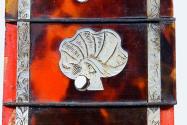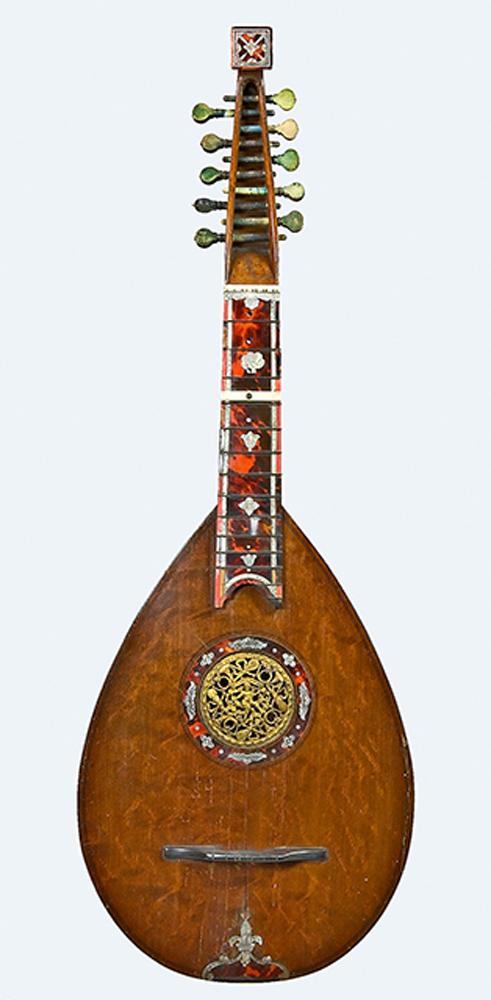Home
>
Works
>
English guittar
>
Advanced Search
Plucked Strings
Citterns and English Guitars
English guittar
Alternate name:English guitar
Alternate name:Cittern
Maker: John Frederick Hintz
Date: 1761
Place Made:London, England, Europe
Model: Almond shape with lute back
Serial No: none
SignedCast into rose, on banner: 17 F HINTZ 61
DescriptionThis spectacularly decorated lute-form English guittar was made by Frederick Hintz, a noted German-Moravian furniture and instrument maker who settled in London in the mid-eighteenth century. The English guittar was a wire-string cittern that developed among German-speaking immigrants to London in this time period. By 1763, Hintz was recorded as This Hintz guitar as "Guittar-maker to her Majesty and the Royal Family" in Mortimer's London Universal Dictionary. The NMM's instrument among the earliest and fanciest surviving examples.
Soundboard: two-piece spruce: medium grain with bear-claw figure; engraved and black-ink-filled mother-of-pearl and tortoiseshell inlay over red surface in front of saddle
Bowl: 12 quarter-cut maple staves with medium curl, divided by wide dark hardwood, possibly walnut, stringing; engraved and black-ink-filled mother-of-pearl decorative inlay on center three ribs; engraved and black-ink-filled mother-of-pearl and tortoiseshell decorative trim over red surface at joint with neck, and ivory strap pin
Clasp: maple with dark hardwood trim and festooned tortoiseshell over red surface with engraved and black-ink-filled mother-of-pearl tassels
Head: maple, integral with neck; terminates in square; inlaid on finial, sides, and back of pegbox with engraved and black-ink-filled mother-of-pearl floral and shell decoration set into tortoiseshell on red painted surface and
Neck: maple; integral with head; inlaid on back with two tortoiseshell sections with engraved and black-ink-filled mother-of-pearl flowers
Binding: dark hardwood, possibly walnut, along edge of bowl; double black ink lines on top
Fingerboard: maple veneered with tortoiseshell over red painted surface, engraved and black-ink-filled mother-of-pearl border; 14 iron bar frets; engraved and black-ink-filled mother-of-pearl shell inlays behind 1st and 3rd frets; engraved and black-ink-filled mother-of-pearl flower inlays behind 6th, 9th, and 12th frets; capo holes behind frets 1 to 5; bone and brass capo
Nut: ivory
Bridge: ebony
Tuners: ten green-stained ivory friction pegs with ivory pins
String pins: 10 ivory in clasp, with strings passing over ebony veneer saddle
Rose: Cast brass with figure of cherub and musical instruments (recorders, citterns, horns, and violins) in dentil border
Rosette: mother-of-pearl flowers, dots, and scrolls with engraved, black-ink-filled line decoration, set in tortoiseshell ring over red painted surface, surrounded by three inked lines
Lacquer: red-brown with craquelure
Bowl lining: paper strips over joints between ribs
Soundboard: two-piece spruce: medium grain with bear-claw figure; engraved and black-ink-filled mother-of-pearl and tortoiseshell inlay over red surface in front of saddle
Bowl: 12 quarter-cut maple staves with medium curl, divided by wide dark hardwood, possibly walnut, stringing; engraved and black-ink-filled mother-of-pearl decorative inlay on center three ribs; engraved and black-ink-filled mother-of-pearl and tortoiseshell decorative trim over red surface at joint with neck, and ivory strap pin
Clasp: maple with dark hardwood trim and festooned tortoiseshell over red surface with engraved and black-ink-filled mother-of-pearl tassels
Head: maple, integral with neck; terminates in square; inlaid on finial, sides, and back of pegbox with engraved and black-ink-filled mother-of-pearl floral and shell decoration set into tortoiseshell on red painted surface and
Neck: maple; integral with head; inlaid on back with two tortoiseshell sections with engraved and black-ink-filled mother-of-pearl flowers
Binding: dark hardwood, possibly walnut, along edge of bowl; double black ink lines on top
Fingerboard: maple veneered with tortoiseshell over red painted surface, engraved and black-ink-filled mother-of-pearl border; 14 iron bar frets; engraved and black-ink-filled mother-of-pearl shell inlays behind 1st and 3rd frets; engraved and black-ink-filled mother-of-pearl flower inlays behind 6th, 9th, and 12th frets; capo holes behind frets 1 to 5; bone and brass capo
Nut: ivory
Bridge: ebony
Tuners: ten green-stained ivory friction pegs with ivory pins
String pins: 10 ivory in clasp, with strings passing over ebony veneer saddle
Rose: Cast brass with figure of cherub and musical instruments (recorders, citterns, horns, and violins) in dentil border
Rosette: mother-of-pearl flowers, dots, and scrolls with engraved, black-ink-filled line decoration, set in tortoiseshell ring over red painted surface, surrounded by three inked lines
Lacquer: red-brown with craquelure
Bowl lining: paper strips over joints between ribs
DimensionsTotal English guittar length: 818 mm
Top length: 400 mm
Maximum body width: 283 mm
Maximum bowl height: 90 mm
Head length: 228 mm
Head width, top: 36 mm
Head width, bottom: 45 mm
Neck length (nut to ribs): 178 mm
Neck width, nut: 48 mm
Neck width, heel: 54 mm
Soundhole diameter: 81 mm
Vibrating string length (nut to bridge edge): 469 mm
Top length: 400 mm
Maximum body width: 283 mm
Maximum bowl height: 90 mm
Head length: 228 mm
Head width, top: 36 mm
Head width, bottom: 45 mm
Neck length (nut to ribs): 178 mm
Neck width, nut: 48 mm
Neck width, heel: 54 mm
Soundhole diameter: 81 mm
Vibrating string length (nut to bridge edge): 469 mm
ProvenanceArne B. Larson Collection, Vermillion, South Dakota, 1979.
Terms
Credit Line: Arne B. Larson Collection, 1979
Not on view
Published ReferencesLanie Graf, "John Frederick Hintz, Eighteenth-Century Moravian Instrument Maker, and Use of the Cittern in Moravian Worshop," Journal of Moravian History 5 (Fall 2008), pp. 7-39.
Panagiotis Poulopoulos, The Guittar in the British Isles 1750-1810, Ph.D. Dissertation (Edinburgh, The University of Edinbught, 2011) p. 302, 332, 341, 352, 585, 588
Inventing the American Guitar : the Pre-Civil War Innovations of C.F. Martin and His Contemporaries. Edited by Robert Shaw and Peter Szego (Milwaukee: Hal Leonard Books, 2013), p. 23.
Panagiotis Poulopoulos, The Guittar in the British Isles 1750-1810, Ph.D. Dissertation (Edinburgh, The University of Edinbught, 2011) p. 302, 332, 341, 352, 585, 588
Inventing the American Guitar : the Pre-Civil War Innovations of C.F. Martin and His Contemporaries. Edited by Robert Shaw and Peter Szego (Milwaukee: Hal Leonard Books, 2013), p. 23.
Object number: 01286



































